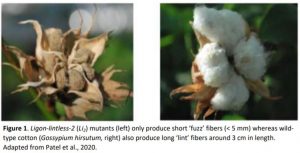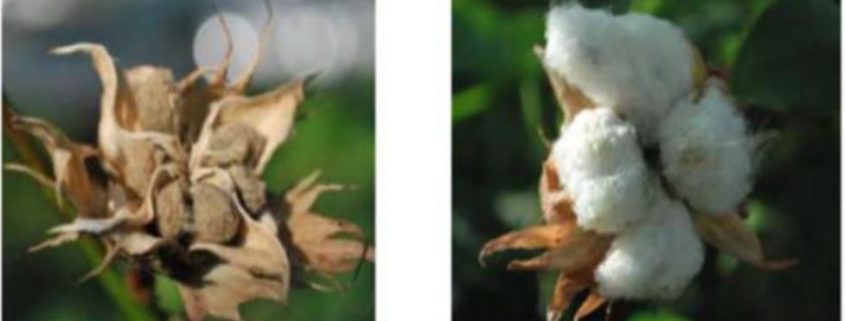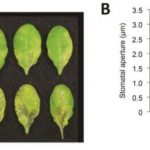From fuzz to fiber – identification of genes involved in cotton fiber elongation
Kim L Johnson
La Trobe Institute for Agriculture & Food, Department of Animal, Plant and Soil Sciences, La Trobe University, Bundoora, Victoria 3086, Australia
Email: [email protected]
 At least some of the clothing you are wearing is likely made of cotton, and you are not alone. Cotton is currently the most common textile fiber used worldwide, and this truly spectacular plant has been used by humans for around 8000 years. The cotton plant (Gossypium spp.) is iconic in producing a highly unusual furry ‘fruit’ containing the seeds (Figure 1). In folklore the cotton plant was called ‘vegetable lamb’ as people thought the fruits were tiny sheep – wool came from sheep so they thought that cotton bolls were tiny sheep that dropped off and started running around! By 1500 cotton was known all over the world and in the next 200 years became a very profitable industry as its demand increased, particularly in America and Europe. The beauty of cotton as a textile is its breathability and smoothness as a fabric, the fineness and quality of the fibers and the number of fibers that are produced per plant.
At least some of the clothing you are wearing is likely made of cotton, and you are not alone. Cotton is currently the most common textile fiber used worldwide, and this truly spectacular plant has been used by humans for around 8000 years. The cotton plant (Gossypium spp.) is iconic in producing a highly unusual furry ‘fruit’ containing the seeds (Figure 1). In folklore the cotton plant was called ‘vegetable lamb’ as people thought the fruits were tiny sheep – wool came from sheep so they thought that cotton bolls were tiny sheep that dropped off and started running around! By 1500 cotton was known all over the world and in the next 200 years became a very profitable industry as its demand increased, particularly in America and Europe. The beauty of cotton as a textile is its breathability and smoothness as a fabric, the fineness and quality of the fibers and the number of fibers that are produced per plant.
So, what exactly is cotton if not tiny sheep? Cotton fibers come from epidermal cells on the seed that elongate from a tiny bump of 10–20 mm to 3–6 cm in length (Kim and Triplett, 2001). Let’s just consider that for a moment – the cell elongates up to 3000 times its initial size! This is incredible! Neurons in animals have the potential to grow up to an impressive 20 times their initial size yet this pales in comparison to these amazing cotton fibers. To extend so dramatically cotton fibers have incredibly strong walls, ending up with cellulose-rich secondary walls around 4 mm thick.
Around 25% of epidermal cells form the long ‘lint’ fibers so valued by the textile industry and the remainder form ‘fuzz’ fibers of around 5 mm in length. It is unclear why fuzz fibers do not elongate beyond this length. Developmental mutants and cotton species that display diverse fiber characteristics are excellent resources to study the mechanisms leading to highly elongated fibers. Of these, the Ligon-lintless (Li1 and Li2) mutants develop only fuzz fibers. In this issue, Patel et al. (2020) investigate Ligon-lintless-2 (Li2), a dominant mutant that otherwise displays normal vegetative growth (Figure 1). The Li2 mutation occurs in the tetraploid Gossypium hirsutum background and although the causal mutation has previously been mapped to Chromosome 18, identification of the exact region has proven challenging. In this study, Patel et al. (2020) used genetic markers, chromosome walking and sequencing to identify a deletion near the end of Chromosome 18, leading to haploinsufficiency and the Li2 phenotype. Among the 35 genes in the deletion region, 10 had putative roles in fiber development, including cell wall synthesis and hormone regulation, and many of these also display coding differences between ancestral cotton (diploid) genomes that do not produce elongated fibers and elongated fiber-producing (tetraploid) genomes (Paterson et al., 2012). Expression studies showed the majority of the 10 genes display differences between wild-type and Li2 mutants during fiber development (Patel et al., 2020). Virus induced gene silencing (VIGS) of the 10 candidate genes confirmed that two encoding putative glycosyltransferase 1 family members, UGT87A2 and UGT87A1-D1a contribute to the Li2 phenotype with VIGS leading to reduced fiber length. UGT87A1 and UGT87A2 family members are proposed to act in pathways that influence fiber elongation, including ABA (abscisic acid) and ascorbic acid homeostasis, cell wall biosynthesis, and control of H2O2 levels (Wang et al., 2012; Li et al., 2017; Rehman et al., 2018).
Based on the Li2 phenotypes, VIGS and the expression data, Patel et al. suggest that the genes in the deleted region are coordinately regulated despite their functional diversity, and potentially have interrelated roles during fiber development: acting in cell wall synthesis and remodeling, hormone synthesis and protein degradation. This is consistent with studies comparing cotton genomes that suggest many fiber-quality related QTLs co-locate and are coordinately expressed, likely as a result of non-reciprocal DNA exchanges during domestication (Paterson et al., 2012). It is possible the end of Chromosome 18 is one such region. Transcriptional studies of cotton fibers show a hierarchical cascade of transcription factor activation and repression that regulates cell wall polysaccharides, lignin, and protein composition, similar to other secondary cell walls (MacMillan et al., 2017). Domestication and selection to breed modern cotton seed fibers is suggested to have re-programmed secondary cell wall development to suppress lignin biosynthesis whilst recruiting stress-response genes needed to achieve greater fiber cell length and strength useful for the textile industry (Tuttle et al., 2015; MacMillan et al., 2017). Cotton is an excellent system to study cell elongation and cell wall biosynthesis processes and the complex interplay between them. Recent advances in sequencing and bioinformatics have facilitated a new era in exploring genetic regulators in the large and complex cotton genome (Yang et al., 2020). Further studies of the ‘fuzz’ and ‘lint’ regulatory pathways can be used to identify developmental regulators that contribute to initiation, elongation, secondary wall biosynthesis and maturation of cotton fibers – and potentially breeding of the hairiest vegetable lamb cottons you will so want to be wearing next season.
References
Kim HJ, Triplett BA (2001) Cotton fiber growth in planta and in vitro. Models for plant cell elongation and cell wall biogenesis. Plant Physiol 127: 1361-1366
Li P, Li YJ, Wang B, Yu HM, Li Q, Hou BK (2017) The Arabidopsis UGT87A2, a stress-inducible family 1 glycosyltransferase, is involved in the plant adaptation to abiotic stresses. Physiol Plant 159: 416-432
MacMillan CP, Birke H, Chuah A, Brill E, Tsuji Y, Ralph J, Dennis ES, Llewellyn D, Pettolino FA (2017) Tissue and cell-specific transcriptomes in cotton reveal the subtleties of gene regulation underlying the diversity of plant secondary cell walls. BMC Genomics 18: 539
Patel JD, Huang X, Lin L, Das S, Chandnani R, Khanal S, Adhikari J, Shehzad T, Guo H, Roy-Zokan EM, Rong J, and Paterson AH (2020) The Li2 short fiber mutant locates within a terminal deletion of chromosome 18. Plant Physiology https://doi.org/10.1104/pp.19.01531
Paterson AH, Wendel JF, Gundlach H, Guo H, Jenkins J, Jin D, Llewellyn D, Showmaker KC, Shu S, Udall J, Yoo MJ, Byers R, Chen W, Doron-Faigenboim A, Duke MV, Gong L, Grimwood J, Grover C, Grupp K, Hu G, Lee TH, Li J, Lin L, Liu T, Marler BS, Page JT, Roberts AW, Romanel E, Sanders WS, Szadkowski E, Tan X, Tang H, Xu C, Wang J, Wang Z, Zhang D, Zhang L, Ashrafi H, Bedon F, Bowers JE, Brubaker CL, Chee PW, Das S, Gingle AR, Haigler CH, Harker D, Hoffmann LV, Hovav R, Jones DC, Lemke C, Mansoor S, ur Rahman M, Rainville LN, Rambani A, Reddy UK, Rong JK, Saranga Y, Scheffler BE, Scheffler JA, Stelly DM, Triplett BA, Van Deynze A, Vaslin MF, Waghmare VN, Walford SA, Wright RJ, Zaki EA, Zhang T, Dennis ES, Mayer KF, Peterson DG, Rokhsar DS, Wang X, Schmutz J (2012) Repeated polyploidization of Gossypium genomes and the evolution of spinnable cotton fibres. Nature 492: 423-427
Rehman HM, Nawaz MA, Shah ZH, Ludwig-Muller J, Chung G, Ahmad MQ, Yang SH, Lee SI (2018) Comparative genomic and transcriptomic analyses of Family-1 UDP glycosyltransferase in three Brassica species and Arabidopsis indicates stress-responsive regulation. Sci Rep 8: 1875
Tuttle JR, Nah G, Duke MV, Alexander DC, Guan X, Song Q, Chen ZJ, Scheffler BE, Haigler CH (2015) Metabolomic and transcriptomic insights into how cotton fiber transitions to secondary wall synthesis, represses lignification, and prolongs elongation. BMC Genomics 16: 477
Wang B, Jin SH, Hu HQ, Sun YG, Wang YW, Han P, Hou BK (2012) UGT87A2, an Arabidopsis glycosyltransferase, regulates flowering time via FLOWERING LOCUS C. New Phytol 194: 666-675
Yang Z, Qanmber G, Wang Z, Yang Z, Li F (2020) Gossypium Genomics: Trends, Scope, and Utilization for Cotton Improvement. Trends Plant Sci




